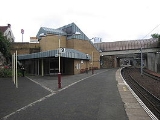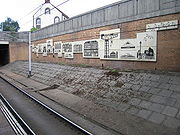
Exhibition Centre railway station
Encyclopedia
Exhibition Centre station - previously called Finnieston [1979-1986] and earlier Stobcross [1894-1959] (due to its location in the Stobcross area of the city) - is in Glasgow
on the Argyle Line
. It serves the Scottish Exhibition and Conference Centre
, which is accessible by adjoining footbridge
from an island platform
. The station suffers badly from congestion at concerts as most of Greater Glasgow
can be reached from the station. There is a siding
adjacent to Platform 2, that can be used as a turnback siding for trains terminating at Anderston
or Glasgow Central Low Level. The line is served by Class 334s
and Class 318s
. From May 2011, the line will be served by Class 318s and Class 320s
.
, with a platform where the overhead
electrification
masts are currently located. Just inside the tunnel from Partick, there was a junction
.
 The route, now disused, to the north went to the Glasgow Central Railway's
The route, now disused, to the north went to the Glasgow Central Railway's
Maryhill Central
.
The route to the west is partially used by the Argyle Line
link to the Clyde North Line
(a new single track tunnel being constructed to connect up at Finnieston West Junction). Previously the line went to Partick Central railway station
(which at one time had been renamed ) and onwards along the River Clyde
to Dumbarton.
bursting its banks at Kelvinbridge
and the resultant torrent through the disused Glasgow Central Railway tunnel flooded the Argyle Line
trapping Class 314 Units
at Glasgow Central Low Level.
At 08:34 on Monday 3 September 2007, a set of empty coaches derailed after leaving the sidings at Exhibition Centre to start the 08:38 service from Anderston to Motherwell. This derailment resulted in two members of staff being injured and the line between Partick and Rutherglen being closed for two days.
Glasgow
Glasgow is the largest city in Scotland and third most populous in the United Kingdom. The city is situated on the River Clyde in the country's west central lowlands...
on the Argyle Line
Argyle Line
The Argyle Line is a suburban railway located in West Central Scotland. It connects the Lanarkshire towns of Lanark, Larkhall and Motherwell to West Dunbartonshire via central Glasgow using sub-surface running...
. It serves the Scottish Exhibition and Conference Centre
Scottish Exhibition and Conference Centre
The Scottish Exhibition and Conference Centre , located on the north bank of the River Clyde, in Glasgow, is Scotland's largest exhibition centre....
, which is accessible by adjoining footbridge
Footbridge
A footbridge or pedestrian bridge is a bridge designed for pedestrians and in some cases cyclists, animal traffic and horse riders, rather than vehicular traffic. Footbridges complement the landscape and can be used decoratively to visually link two distinct areas or to signal a transaction...
from an island platform
Island platform
An island platform is a station layout arrangement where a single platform is positioned between two tracks within a railway station, tram stop or transitway interchange...
. The station suffers badly from congestion at concerts as most of Greater Glasgow
Greater Glasgow
Greater Glasgow is an urban settlement in Scotland consisting of all localities which are physically attached to the city of Glasgow, forming with it a single contiguous urban area...
can be reached from the station. There is a siding
Rail siding
A siding, in rail terminology, is a low-speed track section distinct from a running line or through route such as a main line or branch line or spur. It may connect to through track or to other sidings at either end...
adjacent to Platform 2, that can be used as a turnback siding for trains terminating at Anderston
Anderston
Anderston is a district in the Scottish city of Glasgow. It is on the north bank of the River Clyde and extends to the western edge of the city centre...
or Glasgow Central Low Level. The line is served by Class 334s
British Rail Class 334
The British Rail Class 334 is a suburban electric multiple unit built by Alstom in Birmingham. They are part of the Juniper family of trains along with Classes 458 and 460. They were built for SPT/ScotRail outer suburban services in Glasgow, UK. They later became part of First ScotRail/SPT fleet...
and Class 318s
British Rail Class 318
The British Rail Class 318 is an electric multiple unit train, which operates exclusively in the Strathclyde Partnership for Transport network in West Central Scotland. The units were introduced fully on 29 September 1986 as part of the electrification of the Ayrshire Coast Line between and...
. From May 2011, the line will be served by Class 318s and Class 320s
British Rail Class 320
The British Rail Class 320 is an alternating current electric multiple unit train found on the Strathclyde Partnership for Transport rail network in Central Scotland, and is used exclusively on the North Clyde Line between Helensburgh and Airdrie, North Lanarkshire via Glasgow Queen Street...
.
History
In the days when the station was named Stobcross, the formation in front of Platform 1 was originally double trackDouble track
A double track railway usually involves running one track in each direction, compared to a single track railway where trains in both directions share the same track.- Overview :...
, with a platform where the overhead
Overhead lines
Overhead lines or overhead wires are used to transmit electrical energy to trams, trolleybuses or trains at a distance from the energy supply point...
electrification
Railway electrification in Great Britain
Railway electrification in Great Britain started towards of the 19th century. A great range of voltages have been used in the intervening period using both overhead lines and third rails, however the most common standard for mainline services is now 25 kV AC using overhead lines and the...
masts are currently located. Just inside the tunnel from Partick, there was a junction
Junction (rail)
A junction, in the context of rail transport, is a place at which two or more rail routes converge or diverge.This implies a physical connection between the tracks of the two routes , 'points' and signalling.one or two tracks each meet at a junction, a fairly simple layout of tracks suffices to...
.

Glasgow Central Railway
The Glasgow Central Railway was a railway that ran from Maryhill in the north west of Glasgow through the West End and City Centre to Rutherglen and Newton to the south east of the city.- Early days :...
Maryhill Central
Maryhill Central railway station
- Location :To the west of the station was a triangular set of junctions. Immediately to the west was Maryhill Central junction where the line to Kirklee diverged to the south and the Lanarkshire and Dunbartonshire Railway headed east to Bellshaugh Junction where the western side of the triangle ...
.
The route to the west is partially used by the Argyle Line
Argyle Line
The Argyle Line is a suburban railway located in West Central Scotland. It connects the Lanarkshire towns of Lanark, Larkhall and Motherwell to West Dunbartonshire via central Glasgow using sub-surface running...
link to the Clyde North Line
North Clyde Line
The North Clyde Line is a suburban railway in West Central Scotland. The route is operated by First ScotRail, on behalf of Transport Scotland...
(a new single track tunnel being constructed to connect up at Finnieston West Junction). Previously the line went to Partick Central railway station
Partick Central railway station
Partick Central railway station was a railway station serving the Partick area of the city of Glasgow. Built in the 1890s by the Lanarkshire and Dunbartonshire Railway Company, it sat on a line that ran along the north bank of the River Clyde from Stobcross to Dumbarton.- History :The station was...
(which at one time had been renamed ) and onwards along the River Clyde
River Clyde
The River Clyde is a major river in Scotland. It is the ninth longest river in the United Kingdom, and the third longest in Scotland. Flowing through the major city of Glasgow, it was an important river for shipbuilding and trade in the British Empire....
to Dumbarton.
Incidents
Heavy rain in December 1994 resulted in the River KelvinRiver Kelvin
The Kelvin rises on watershed of Scotland on the moor south east of the village of Banton, east of Kilsyth - . At almost 22 miles long, it initially flows south to Dullatur Bog where it falls into a man made trench and takes a ninety degree turn flowing west along the northern boundary of the bog...
bursting its banks at Kelvinbridge
Kelvinbridge railway station
Kelvinbridge was a railway station for the Kelvinbridge area in the West End of Glasgow, close to Kelvinbridge subway station on the Glasgow Subway.-Chronology:This station was opened on 10 August 1896....
and the resultant torrent through the disused Glasgow Central Railway tunnel flooded the Argyle Line
Argyle Line
The Argyle Line is a suburban railway located in West Central Scotland. It connects the Lanarkshire towns of Lanark, Larkhall and Motherwell to West Dunbartonshire via central Glasgow using sub-surface running...
trapping Class 314 Units
British Rail Class 314
British Rail Class 314 alternating current electric multiple units were built by BREL at York works in 1979. They were the third variety of British Rail's then-standard 1972 design for suburban EMUs, which eventually encompassed 755 vehicles and five classes...
at Glasgow Central Low Level.
At 08:34 on Monday 3 September 2007, a set of empty coaches derailed after leaving the sidings at Exhibition Centre to start the 08:38 service from Anderston to Motherwell. This derailment resulted in two members of staff being injured and the line between Partick and Rutherglen being closed for two days.

